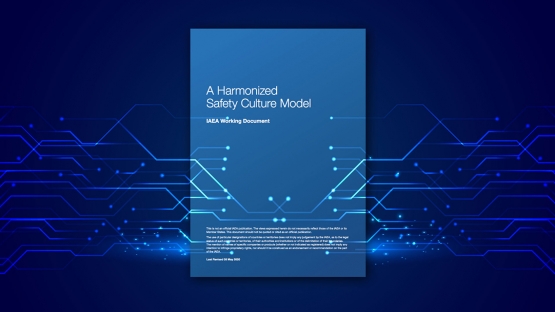
Safety culture refers to how an organizational culture prioritizes and values safety; it is shaped by the shared attitudes, norms, beliefs and values of all employees. Weaknesses in safety culture have proven to contribute significantly to incidents and accidents across different industries, including the nuclear industry. But how can an organization know if it has an effective culture for safety?
“Culture is so powerful because it often affects our behaviour unconsciously,” said Caroline Pike, who advises national experts on safety culture in the nuclear industry at the IAEA. “This is why it is important that people understand the characteristics of an effective safety culture, and organizations have in place a set of behavioural indicators to help gauge its strength and quality.”
The IAEA’s newly published Harmonized Safety Culture Model describes the traits and attributes that are observed when a strong culture for safety is present. It lists exemplary behaviours such as individual responsibility for safety, questioning attitude, responsibilities for decision‑making, and highlights effective communication and high level of trust as some of the major indicators of a healthy culture for safety. The Model is a comprehensive tool intended for all organizations that deal directly or indirectly with ionizing radiation, enabling them to set goals, implement changes, and measure progress.
“A model that concretely describes the aspects needed in an organization’s safety culture is required to demonstrate that safety culture is not just an ‘add-on’ to everyday operations or a ‘quick fix’ to performance issues,” said Pia Oedewald, Principal Advisor in Finland’s Radiation and Nuclear Safety Authority (STUK). “This opens avenues for genuine self-reflections and more effective safety culture development actions.”
Nuclear and nuclear-related organizations had been experiencing challenges in complying with different sets of safety culture guidelines that were similar in intent but different in structure, Pike said. “This can create unnecessary complexity and uncertainty in understanding expectations and implementing programmes to enhance safety culture. It can also make measurement and assessment of safety culture more difficult.”
To address those challenges, the IAEA initiated a process in 2016 to harmonize those different sets of guidelines. Participants from different countries and facilities discussed existing safety culture frameworks from institutions including the IAEA, the World Association of Nuclear Operators (WANO) and the Institute of Nuclear Power Operations (INPO) as well as government institutions from Finland, Japan and the United States. They paid special attention to the gaps between existing frameworks, Pike said. This work resulted in the new Harmonized Safety Culture Model, which will make it easier for national experts and operators to understand and enhance their culture for safety, protecting workers, communities and the environment.
The Model is written in a way that is translatable to other languages and cultures, as well as relevant for facilities other than nuclear power plants, making it widely applicable. It includes specific attributes defining current international expectations.
“We believe these concepts will translate well for all those different countries who are running commercial nuclear power plants,” added Ian Moss, Deputy Director, WANO Leadership, Training and Development. “The traits recognize the special nature of nuclear energy and they reinforce the attention warranted by leaders in this unique industry.”
The Model is not intended as a checklist but represents overarching principles and provides a description of the traits and attributes that are present in organizations with an effective culture for safety. It is aligned with a systemic approach to understanding culture for safety in different organizations. It is recommended that each of the industries customize the model to fit their particular needs.
The Harmonized Safety Culture Model will be the part of Application of the Management System for Facilities and Activities, which is currently being updated and is expected to be finalized by the end of 2020 and published in the IAEA Safety Reports Series. It will also be integrated into the IAEA Independent Safety Culture Assessment (ISCA) by providing additional normative criteria for assessing safety culture.

